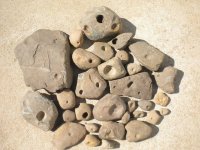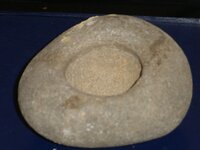Seadog
Newbie
- Jun 16, 2012
- 3
- 3
- Detector(s) used
- White's Classic ID
- Primary Interest:
- All Treasure Hunting
Hello All!
I am a new member to the site. I live in Northern Illinois. I was on a construction site in McHenry County walking along a road adjacent to a farm field when I spotted a rock that looked like it had a brown circle on the side and picked it up. I had seen something like this before so I took it home. From what I can determine is the rock is what is sometimes called a "nutting stone". I have found arrow heads before but this is the first one of these I've found. Any info or help would be appreciated. I'll post some pics.
I am a new member to the site. I live in Northern Illinois. I was on a construction site in McHenry County walking along a road adjacent to a farm field when I spotted a rock that looked like it had a brown circle on the side and picked it up. I had seen something like this before so I took it home. From what I can determine is the rock is what is sometimes called a "nutting stone". I have found arrow heads before but this is the first one of these I've found. Any info or help would be appreciated. I'll post some pics.
Attachments
Upvote
0










